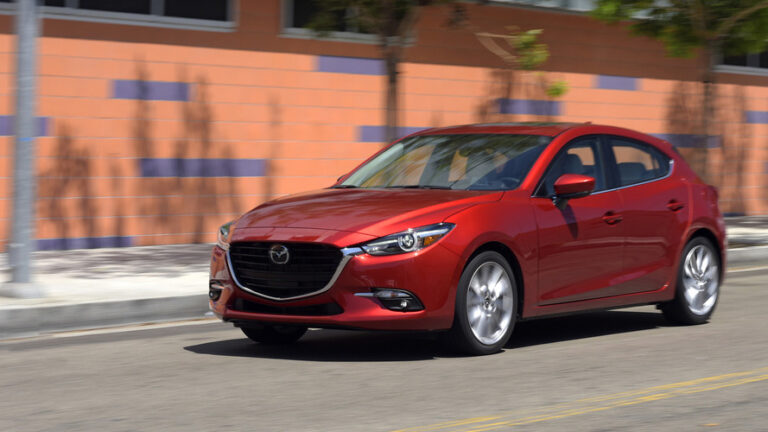Car Brand Decals: Beyond the Badge – A Comprehensive Guide
Car Brand Decals: Beyond the Badge – A Comprehensive Guide cars.truckstrend.com
From the subtle script on a fender to the bold emblem adorning a grille, car brand decals are far more than mere decorative elements. They are the silent ambassadors of automotive identity, performance, and legacy. In a world where vehicles are increasingly personalized, these seemingly small details play a monumental role in shaping perception, conveying status, and even influencing resale value. This comprehensive guide will delve into the intricate world of car brand decals, exploring their various forms, purposes, maintenance, and the art of their removal and replacement.
What Are Car Brand Decals? Defining the Essentials
Car Brand Decals: Beyond the Badge – A Comprehensive Guide
At its core, a car brand decal is any adhesive graphic, emblem, or script applied to a vehicle that signifies its manufacturer, model, trim level, special edition, or performance characteristics. While the term "decal" might conjure images of simple stickers, in the automotive context, it encompasses a wide array of materials and applications. This includes, but is not limited to:
- Manufacturer Logos/Emblems: The iconic symbols that instantly identify the brand (e.g., Mercedes-Benz star, BMW roundel, Ford oval).
- Model Names: Script or block lettering indicating the specific model (e.g., "Corolla," "F-150," "Civic").
- Trim Level Indicators: Badges denoting a specific trim or package (e.g., "SE," "Limited," "XLT," "Touring").
- Performance Badging: Decals highlighting a vehicle’s performance credentials (e.g., "AMG," "M," "Type R," "SRT," "Turbo").
- Engine Specification Decals: Indicating engine size or type (e.g., "V6," "2.0T," "Hybrid").
- Special Edition Identifiers: Unique badges for limited production runs (e.g., "Anniversary Edition," "Black Edition").
- Dealer Decals: Small stickers or badges applied by the selling dealership.
- Aftermarket Brand Decals: Logos of tuning companies, parts manufacturers, or specific performance brands installed by owners.

These decals can be crafted from various materials, including chromed plastic, polished metal, durable vinyl, 3D resin, and even sophisticated composite materials, designed to withstand the harsh automotive environment. Their placement is strategic, typically found on the trunk lid, fenders, grille, doors, and sometimes even within the interior.
The Purpose and Power of Car Brand Decals

The presence of car brand decals extends far beyond mere aesthetics; they serve multiple critical functions within the automotive ecosystem.
Brand Identity & Recognition
This is perhaps the most obvious purpose. Decals act as instant identifiers, allowing consumers to immediately recognize a vehicle’s make and model. They are crucial for reinforcing brand loyalty and creating a strong visual presence on the road. A well-designed logo or model name can evoke feelings of luxury, reliability, sportiness, or ruggedness, aligning with the brand’s core values.
Marketing & Value Proposition
Decals are powerful marketing tools. Performance badges like "AMG" or "M" immediately communicate a vehicle’s high-performance capabilities, justifying a premium price. Trim level decals help differentiate models within the same lineup, guiding consumers toward specific features and price points. They highlight what makes a particular vehicle special, whether it’s fuel efficiency ("Hybrid"), off-road prowess ("4×4"), or advanced technology.

Aesthetics & Design Integration
Automotive designers meticulously integrate decals into the overall vehicle design. They are not merely slapped on; their size, font, finish, and placement are carefully considered to complement the car’s lines and proportions. A sleek, minimalist script might suit a luxury sedan, while a bold, angular emblem could enhance the aggressive stance of a sports car. They are integral to the vehicle’s visual identity.
Resale Value & Authenticity
Original Equipment Manufacturer (OEM) decals contribute to a vehicle’s authenticity and can positively impact its resale value. The presence of factory-installed badging assures potential buyers that the vehicle is as specified, especially for rare trims or performance models. Conversely, missing or incorrect badging can raise questions about a vehicle’s history or specifications.
Personalization & Expression (Aftermarket)
Beyond OEM decals, the aftermarket industry offers a vast array of brand decals for personalization. Enthusiasts might add decals from their favorite tuning companies, car clubs, or even custom graphics that express their unique style or affiliations. This allows owners to make their vehicle truly their own, showcasing their passion and individuality.
Types of Car Brand Decals: A Categorization
Understanding the different categories of car brand decals can help in appreciating their diverse roles:
- OEM (Original Equipment Manufacturer) Decals: These are the decals and emblems installed by the car manufacturer at the factory. They include the primary brand logo, model names, trim levels, engine specifications, and any special edition badges. They are designed for durability and perfect integration with the vehicle’s design.
- Aftermarket Performance Decals: These are often added by owners to signify performance upgrades or affiliations with specific tuning brands (e.g., HKS, GReddy, Borla). While some might be purely aesthetic, many represent actual modifications.
- Aftermarket Styling Decals: This broad category includes decorative stripes, hood graphics, side skirt decals, and other visual enhancements that don’t necessarily relate to performance but aim to alter the vehicle’s appearance. These can range from subtle accents to full-body wraps.
- Personalization & Club Decals: These are decals that allow owners to express their personality, support a cause, identify with a car club, or display a humorous message. These are highly varied and reflect the owner’s individual taste.
- Protective Decals: While not strictly "brand" decals, clear protective films (often called "clear bra" or Paint Protection Film – PPF) are applied to vehicle surfaces to prevent stone chips and scratches. Some manufacturers offer branded versions of these films.
Decal Care and Maintenance: Practical Advice for Longevity
To ensure your car brand decals retain their crispness and adhesion, proper care is essential.
- Gentle Cleaning: When washing your car, avoid using harsh chemicals, abrasive sponges, or high-pressure washers directly on decals, especially older ones. Use a soft microfiber cloth and a mild car shampoo. For stubborn grime around emblems, use a soft detailing brush.
- Avoid Wax Buildup: Wax can accumulate around the edges of raised emblems, making them look unsightly. Use a cotton swab or a soft brush to remove wax residue from crevices. For vinyl decals, use a wax-safe detailer or sealant designed for vinyl.
- UV Protection: Prolonged exposure to direct sunlight can cause decals to fade, crack, or peel. Parking in the shade or using a car cover can significantly extend their lifespan. Applying a UV-protective spray specifically designed for vinyl or plastics can also help.
- Inspect Regularly: Periodically check decals for signs of peeling, bubbling, or cracking. Addressing minor issues early can prevent them from worsening.
- Automatic Car Washes: While convenient, automatic car washes with harsh brushes can damage or lift decals. Touchless car washes are a safer option, but hand washing is always preferred for delicate areas.
Common issues include fading (especially on black or red vinyl), cracking (due to UV exposure and age), and peeling (due to adhesive failure or improper application). By following these tips, you can significantly prolong the life and appearance of your decals.
Removing and Replacing Car Brand Decals: A How-To Guide
Whether you’re de-badging for a cleaner look, replacing damaged emblems, or upgrading to a custom decal, knowing the correct procedure is crucial to avoid paint damage.
Why Remove Decals?
- Aesthetic Preference: Many enthusiasts prefer a "de-badged" look for a cleaner, more minimalist appearance.
- Damage/Wear: Decals can become faded, cracked, or chipped over time, necessitating replacement.
- Upgrades: Swapping out standard badges for performance-oriented or custom versions.
- Paint Correction: Decals might need to be removed to properly polish or paint-correct the area underneath.
Tools Needed for Removal:
- Heat gun or hair dryer
- Fishing line (20-30 lb test) or dental floss
- Plastic trim removal tools or an old credit card
- Automotive adhesive remover (e.g., Goo Gone Automotive, 3M Adhesive Remover)
- Microfiber cloths
- Rubbing alcohol (optional, for final cleaning)
- Car wax or sealant
Step-by-Step Decal Removal:
- Clean the Area: Wash the area around the decal thoroughly to remove dirt and grime.
- Heat the Decal: Use a heat gun or hair dryer on a low-to-medium setting to gently warm the decal and the adhesive underneath. Move the heat source constantly to avoid overheating any single spot, which could damage the paint. Heat makes the adhesive pliable.
- Cut Through Adhesive (for Emblems): For raised emblems, take a piece of fishing line or dental floss and, while the adhesive is warm, slide it behind the emblem using a sawing motion. Work slowly and carefully, pulling the line through the adhesive.
- Pry Gently (for Decals/Remaining Emblems): Once the bulk of the adhesive is cut, use a plastic trim tool or an old credit card to gently pry the decal or emblem off. Do not use metal tools, as they can scratch the paint.
- Remove Adhesive Residue: This is the most crucial step. Spray automotive adhesive remover onto a microfiber cloth (not directly onto the paint, especially if it’s an older finish) and gently wipe away the remaining adhesive. For stubborn residue, let the remover sit for a minute or two, then gently rub. Be patient and use multiple clean cloths.
- Clean and Polish: Once all residue is gone, clean the area with rubbing alcohol to remove any adhesive remover residue. Then, apply a small amount of car polish to remove any "ghosting" (a faint outline where the decal once was) and restore the paint’s shine. Finish with wax or sealant for protection.
Considerations for Replacement:
- OEM vs. Aftermarket Quality: OEM decals generally offer superior quality, fit, and finish. Aftermarket options can vary widely.
- Adhesive Type: Most new emblems come with pre-applied 3M automotive-grade double-sided tape. If not, use high-quality automotive adhesive tape.
- Precise Placement: For accurate alignment, especially for script decals or multiple badges, measure carefully. Use masking tape to mark the exact position before applying the new decal. Some OEM decals come with a template.
- Surface Preparation: Ensure the surface is perfectly clean, dry, and free of wax, silicone, or any residue before applying new decals. Use rubbing alcohol for a final wipe.
- Temperature: Apply new decals in moderate temperatures (ideally 60-80°F / 15-27°C) for optimal adhesive bonding. Avoid extreme heat or cold.
Potential Challenges:
- Paint Damage: The biggest risk during removal is scratching or damaging the paint, especially if metal tools are used or too much force is applied.
- Stubborn Adhesive: Older decals or those exposed to extreme conditions can leave behind very stubborn adhesive residue.
- Ghosting/Fading: The paint under a decal might be less faded than the surrounding paint, creating a visible "ghost" outline. This can often be corrected with polishing.
- Misalignment: Applying new decals crookedly can be frustrating and difficult to correct once adhered.
Car Brand Decals: Estimated Price Table
| Decal Type | Description | Estimated Price Range (USD) | Key Considerations |
|---|---|---|---|
| OEM Brand Logo/Emblem | Factory-original emblem for grille, trunk, or fender (e.g., Honda H, BMW Roundel) | $20 – $150+ | Authenticity, specific model/year fit, material (plastic, metal), complexity (e.g., illuminated emblems). |
| OEM Model Name/Trim Decal | Factory-original script or block lettering (e.g., "Camry," "Limited," "V6") | $15 – $75 | Specific font/size for model/year, availability for older models. |
| OEM Performance Badge | Factory-original high-performance designation (e.g., "AMG," "M," "Type R," "SRT") | $40 – $200+ | Authenticity, specific sub-model fit, material, perceived value. |
| Aftermarket Vinyl Decal (Small) | Custom cut vinyl (e.g., small club logo, simple graphic) | $5 – $30 | Quality of vinyl (Oracal, 3M), complexity of design, color options, seller reputation. |
| Aftermarket Vinyl Decal (Large) | Large graphic, stripe kit, or hood decal | $50 – $300+ | Size, complexity, multiple colors, professional design services, quality of vinyl, installation difficulty. |
| Aftermarket 3D/Domed Decal | Raised, resin-coated decal for custom branding or replica badges | $20 – $80 | Material quality, durability of resin, custom design availability. |
| Professional Decal Removal | Service to safely remove existing decals and clean residue | $50 – $150 (per area) | Number of decals, stubbornness of adhesive, potential for ghosting, paint correction needed afterwards. |
| Professional Decal Installation | Service for precise application of new decals, especially large or complex ones | $75 – $300+ | Size and complexity of decal, surface preparation, guarantees against bubbles/misalignment. |
Note: Prices are estimates and can vary significantly based on vehicle make/model, decal complexity, material quality, seller, and professional service provider location.
Frequently Asked Questions (FAQ) About Car Brand Decals
Q1: Are car brand decals permanent?
A1: OEM car brand decals are designed for long-term durability, but they are not permanent in the sense that they can be removed. Their adhesive can weaken over time due to environmental factors.
Q2: Can I remove decals without damaging the paint?
A2: Yes, with the right tools (heat gun, fishing line, adhesive remover) and proper technique, decals can be removed without damaging the paint. Patience and careful execution are key to avoiding scratches or marring.
Q3: What’s the best way to clean car brand decals?
A3: Use mild car shampoo, a soft microfiber cloth, and plenty of water. Avoid abrasive cleaners, harsh chemicals, or high-pressure washers directly on the decals, especially around their edges.
Q4: Where can I buy genuine OEM car brand decals?
A4: Genuine OEM decals can be purchased from authorized dealership parts departments, reputable online OEM parts retailers, or sometimes directly from the manufacturer’s accessories website.
Q5: Do decals affect resale value?
A5: OEM decals generally do not negatively affect resale value; in fact, their presence indicates authenticity. Aftermarket or custom decals, especially if poorly applied or overly flamboyant, might deter some buyers and could potentially lower resale value, requiring removal.
Q6: How long do car brand decals typically last?
A6: The lifespan varies. High-quality OEM plastic/metal emblems can last the life of the vehicle (10-15+ years). Vinyl decals typically last 3-7 years, depending on the vinyl quality, sun exposure, and care.
Q7: Can I apply a ceramic coating over car brand decals?
A7: Yes, most ceramic coatings can be safely applied over car brand decals (both OEM and vinyl) and can offer an additional layer of protection against UV rays and environmental contaminants, potentially extending their life.
Conclusion: The Enduring Significance of Car Brand Decals
Car brand decals, whether factory-installed or aftermarket additions, are more than just adhesive markers. They are integral components of a vehicle’s identity, communication tools that convey performance, luxury, and heritage, and canvases for personal expression. From the subtle glint of a chrome emblem to the bold statement of a racing stripe, these details encapsulate the spirit of automotive design and ownership. Understanding their purpose, knowing how to care for them, and mastering the art of their removal and replacement empowers car owners to maintain their vehicle’s pristine condition or transform its aesthetic to perfectly match their vision. In a world of ever-evolving automotive trends, the humble car brand decal remains a timeless and profoundly significant element, connecting drivers to their machines and the brands they represent.






